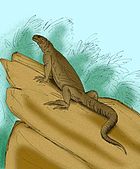Glyptosaurinae
| Glyptosaurinae Temporal range: Late Cretaceous - Paleogene
| |
|---|---|

| |
| Fossil of the glyptosaurine Helodermoides tuberculatus | |
| Scientific classification | |
| Domain: | Eukaryota |
| Kingdom: | Animalia |
| Phylum: | Chordata |
| Class: | Reptilia |
| Order: | Squamata |
| Family: | Anguidae |
| Subfamily: | †Glyptosaurinae Marsh, 1872 |
| Subgroups | |
| |
Glyptosaurinae is an extinct subfamily of anguid lizards that lived in the Northern Hemisphere during the Late Cretaceous and the Paleogene.
Description

Glyptosaurines are known primarily from their osteoderms, scale-like pieces of bone that are embedded in the skin and cover much of their bodies. The shape and extent of the osteoderms in glyptosaurines are similar to those seen in an unrelated group of lizards called Monstersauria, which includes the living Gila monster and beaded lizard.[1] The osteoderms of glyptosaurines are unusually complex, consisting of four distinct layers of bony tissue. These tissues may have derived from both the dermis (the lower layer of the skin) and the epidermis (the outer layer of the skin) during their development in the embryo. The tissue forming the outermost layer of glyptosaurine osteoderms is similar to tooth enamel and has even been given its own name, osteodermine.[2]
Glyptosaurines have been split into the subgroups Melanosaurini and Glyptosaurini, although recent phylogenetic analyses show that Melanosaurini in its traditional sense is paraphyletic, representing an evolutionary grade of glytosaurines more basal ("primitive") than Glyptosaurini. Below is a cladogram from Conrad and Norell (2008) showing the interrelationships of glyptosaurines and their relationship to other anguid lizards:[1]
| Anguimorpha |
| ||||||||||||||||||||||||||||||||||||
References
- ^ a b Conrad, J. L.; Norell, M. A. (2008). "The braincases of two glyptosaurines (anguidae, Squamata) and anguid phylogeny". American Museum Novitates. 3613: 1. doi:10.1206/586.1. hdl:2246/5917.
- ^ De Buffrénil, V.; Dauphin, Y.; Rage, J. C.; Sire, J. Y. (2011). "An enamel-like tissue, osteodermine, on the osteoderms of a fossil anguid (Glyptosaurinae) lizard". Comptes Rendus Palevol. 10 (5–6): 427. doi:10.1016/j.crpv.2011.03.010.





